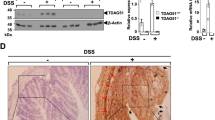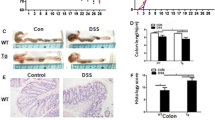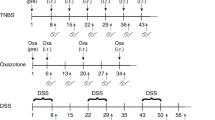Abstract
The molecular mechanisms underlying inflammatory bowel diseases (IBD) are incompletely characterized. MRP-1, normally expressed in the large and small bowel epithelium, serves as a multidrug resistance protein. In this report we explored the role of MRP1 in IBD. Mrp1-deficient mice (mrp1 −/−) were subjected to two different models of IBD. The mrp1 −/− mice and wild-type (WT) mice showed equal induction of TNBS colitis, a hapten-induced T-cell mediated disease. However, in DSS colitis more severe disease was observed in mrp1 −/− mice. In a survival study, mortality of mrp1 −/− mice was higher. In nonlethal DSS colitis, the mean histological colitis score was significantly higher in mrp1 −/− mice and showed particularly severe epithelial damage. Although endogenous LTB4 levels were significantly increased in mrp1 −/− mice, treatment with a LTB4 antagonist did not reduce disease. We conclude that MRP-1 has an important role in the intestinal epithelial resistance to exogenous injury, but MRP-1 does not affect T-lymphocyte mediated mucosal damage.
Similar content being viewed by others
REFERENCES
MacDermott RP: Alterations in the mucosal immune system in ulcerative colitis and Crohn's disease. Med Clin North Am 78:1207–1231, 1994
Podolsky DK: Inflammatory bowel disease (1) (see comments). N Engl J Med 325:928–937, 1991
Sartor RB: Current concepts of the etiology and pathogenesis of ulcerative colitis and Crohn's disease. Gastroenterol Clin North Am. 24:475–507, 1995
Borst P, Evers R, Kool M, Wijnholds J: The multidrug resistance protein family. Biochim Biophys Acta 1461:347–357, 1999
Flens MJ, Zaman GJ, van der Valk P, Izquierdo MA, Schroeijers AB, Scheffer GL, van der Groep P, de Haas M, Meijer CJ, Scheper RJ: Tissue distribution of the multidrug resistance protein. Am J Pathol 148:1237–1247, 1996
Wijnholds J, Evers R, van Leusden MR, Mol CA, Zaman GJ, Mayer U, Beijnen JH, van der Valk M, Krimpenfort P, Borst P: Increased sensitivity to anticancer drugs and decreased inflammatory response in mice lacking the multidrug resistanceassociated protein. Nature Med 3:1275–1279, 1997
Lorico A, Rappa G, Finch RA, Yang D, Flavell RA, Sartorelli AC: Disruption of the murine MRP (multidrug resistance protein) gene leads to increased sensitivity to etoposide (VP-16) and increased levels of glutathione. Cancer Res 57:5238–5242, 1997
Schultz MJ, Wijnholds J, Peppelenbosch MP, Vervoordeldonk MJ, Speelman P, van Deventer SJ, Borst P, van der Poll T: Mice lacking the multidrug resistance protein 1 are resistant to Streptococcus pneumoniae-induced pneumonia. J Immunol 15:4059–4064, 2001
Leier I, Jedlitschky G, Buchholz U, Cole SP, Deeley RG, Keppler D: The MRP gene encodes an ATP-dependent export pump for leukotriene C4 and structurally related conjugates. J Biol Chem 269:27807–27810, 1994
Loe DW, Almquist KC, Deeley RG, Cole SP: Multidrug resistance protein (MRP)-mediated transport of leukotriene C4 and chemotherapeutic agents in membrane vesicles. Demonstration of glutathione-dependent vincristine transport. J Biol Chem 271:9675–9682, 1996
Sharon P, Stenson WF: Enhanced synthesis of leukotriene B4 by colonic mucosa in inflammatory bowel disease. Gastroenterology 86:453–460, 1994
Peskar, BM, Dreyling KW, Peskar BA, May B, Goebell H: Enhanced formation of sulfidopeptide-leukotrienes in ulcerative colitis and Crohn's disease: Inhibition by sulfasalazine and 5-aminosalicylic acid. Agents Actions 18:381–383, 1986
Lauritsen, K, Laursen LS, Bukhave K, Rask-Madsen J: Effects of topical 5-aminosalicylic acid and prednisolone on prostaglandin E2 and leukotriene B4 levels determined by equilibrium in vivo dialysis of rectum in relapsing ulcerative colitis. Gastroenterology 91:837–844, 1986
Izzo RS, Witkon K, Chen AI, Hadjiyane C, Weinstein MI, Pellecchia C: Interleukin-8 and neutrophil markers in colonic mucosa from patients with ulcerative colitis. Am J Gastroenterol 87:1447–1452, 1992
Boerr LA, Sambuelli AM, Filinger E, Peredo H, Graziano A, Valero J, Kogan Z, Bai JC: Increased mucosal levels of leukotriene B4 in pouchitis: Evidence for a persistent inflammatory state. Eur J Gastroenterol Hepatol 8:57–61, 1996
Cole SP, Deeley RG: Multidrug resistance mediated by the ATP-binding cassette transporter protein MRP. Bioessays 20:931–940, 1998
Leier I, Jedlitschky G, Buchholz U, Center M, Cole SP, Deeley RG, Keppler D: ATP-dependent glutathione disulphide transport mediated by the MRP gene-encoded conjugate export pump. Biochem J 314:433–437, 1996
McKenzie SM, Doe WF, Buffinton GD: 5-aminosalicylic acid prevents oxidant mediated damage of glyceraldehyde-3-phosphate dehydrogenase in colon epithelial cells. Gut. 44:180–185, 1999
Lih-Brody L, Powell SR, Collier KP, Reddy GM, Cerchia R, Kahn E, Weissman GS, Katz S, Floyd RA, McKinley MJ, Fisher SE, Mullin GE: Increased oxidative stress and decreased antioxidant defenses in mucosa of inflammatory bowel disease. Dig Dis Sci 41:2078–2086, 1996
McKenzie SJ, Baker MS, Buffinton GD, Doe WF: Evidence of oxidant-induced injury to epithelial cells during inflammatory bowel disease. J Clin Invest 98:136–141, 1996
Yamada T, Grisham MB: Role of neutrophil-derived oxidants in the pathogenesis of intestinal inflammation. Klin Wochenschr 69:988–994, 1991
Elson CO, Sartor RB, Tennyson GS, Riddell RH: Experimental models of inflammatory bowel disease. Gastroenterology. 109:1344–1367, 1995
Duchmann R, May E, Heike M, Knolle P, Neurath M, Meyer zum Buschenfelde KH: T cell specificity and cross reactivity towards enterobacteria, bacteroides, bifidobacterium, and antigens from resident intestinal flora in humans (see comments). Gut 44:812–818, 1999
Prechtl S, Roellinghoff M, Scheper R, Cole SP, Deeley RG, Lohoff M: The multidrug resistance protein 1: A functionally important activation marker for murine Th1 cells. J Immunol 164:754–761, 2000
Blackburn AC, Doe WF, Buffinton GD: Protein carbonyl formation on mucosal proteins in vitro and in dextran sulfate-induced colitis. Free Radic Biol Med. 27:262–270, 1999
Blackburn AC, Doe WF, Buffinton GD: Salicylate hydroxylation as an indicator of hydroxyl radical generation in dextran sulfate-induced colitis. Free Radic Biol Med. 25:305–313, 1998
Buffinton GD, Doe WF: Depleted mucosal antioxidant defences in inflammatory bowel disease. Free Radic Biol Med 19:911–918, 1995
Lohoff M, Prechtl S, Sommer F, Roellinghoff M, Schmitt E, Gradehandt G, Rohwer P, Stride BD, Cole SP, Deeley RG: multidrug-resistance protein (MRP)-like transmembrane pump is highly expressed by resting murine T helper (Th) 2, but not Th1 cells, and is induced to equal expression levels in Th1 and Th2 cells after antigenic stimulation in vivo. J Clin Invest 101:703–710, 1998
Panwala CM, Jones JC, Viney JL: A novel model of inflammatory bowel disease: mice deficient for the multiple drug resistance gene, mdr1a, spontaneously develop colitis. J Immunol 161:5733–5744, 1998
Wijnholds J, deLange EC, Scheffer GL, van den Berg DJ, Mol CA, van der Valk M, Schinkel AH, Scheper RJ, Breimer DD, Borst P: Multidrug resistance protein 1 protects the choroid plexus epithelium and contributes to the blood–cerebrospinal fluid barrier. J Clin Invest 105:279–85, 2000
Wijnholds J, Scheffer GL, van der Valk M, van der Valk P, Beijnen JH, Scheper RJ, Borst P: Multidrug resistance protein 1 protects the oropharyngeal mucosal layer and the testicular tubules against drug-induced damage. J Exp Med 188:797–808, 1998
Evers R, Cnubben NH, Wijnholds J, van Deemter L, van Bladeren PJ, Borst P: Transport of glutathione prostaglandin A conjugates by the multidrug resistance protein 1. FEBS Lett 419:112–116, 1997
Monks TJ, Lau SS: The pharmacology and toxicology of polyphenolic-glutathione conjugates. Annu Rev Pharmacol Toxicol 38:229–55, 1998
Author information
Authors and Affiliations
Rights and permissions
About this article
Cite this article
Ten Hove, T., Drillenburg, P., Wijnholds, J. et al. Differential Susceptibility of Multidrug Resistance Protein-1 Deficient Mice to DSS and TNBS-Induced Colitis. Dig Dis Sci 47, 2056–2063 (2002). https://doi.org/10.1023/A:1019629013945
Issue Date:
DOI: https://doi.org/10.1023/A:1019629013945




